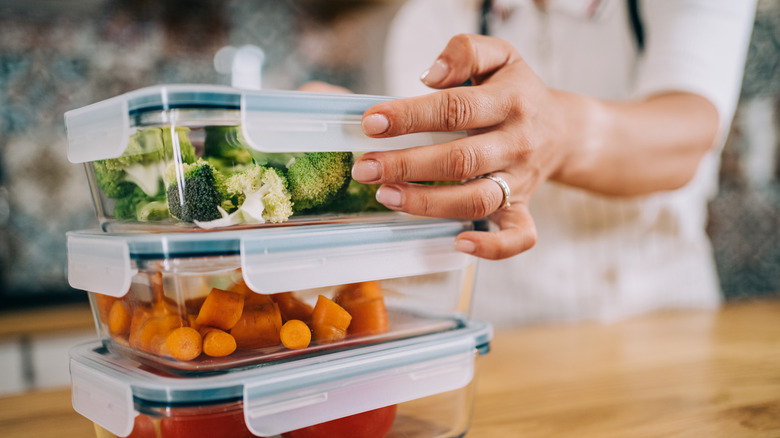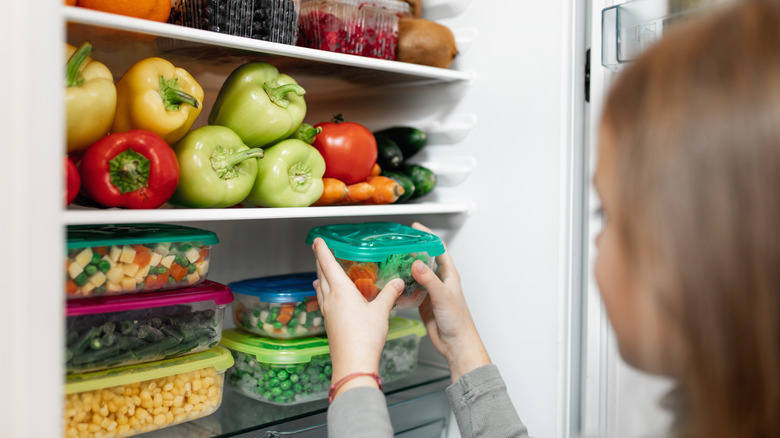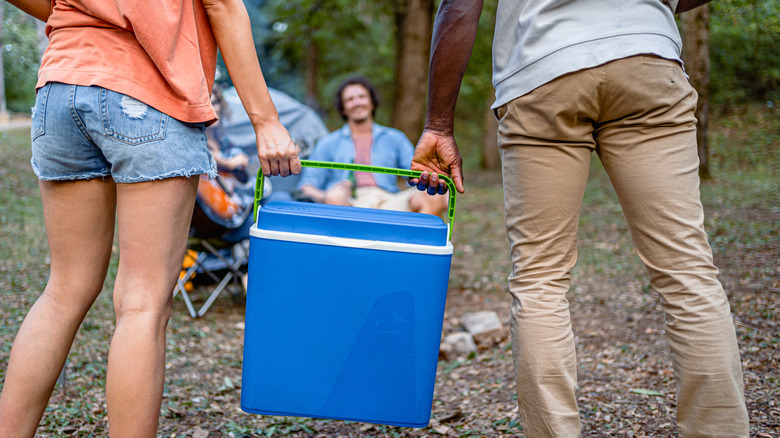Food Storage Mistakes That Are Twice As Dangerous During Summer
After layering up in the colder seasons of the year, summer always feels like a treat. There are more activities to go out and do and seasonal produce you can purchase and enjoy.
Speaking of produce though, the rules change slightly in the storage department when the hotter months roll in. And we're not just talking about fruits that are in season during summer. We're referring to perishable and non-perishable items. Frozen meat that you could've kept sitting out for a few minutes on the kitchen counter might defrost a lot faster, for example. Or you might have noticed that the bunch of visibly semi-ripe bananas that you came home with last evening already looks ready for consumption come morning.
Food storage mistakes can put your health at risk, no matter the season, but the hotter months can make these hiccups all the more dangerous. Warmer temperatures can create the perfect conditions for illness-causing bacteria to flourish. Per the U.S. Department of Agriculture, you should avoid exposing your perishable foods to temperatures between 40 and 140 degrees Fahrenheit. Also, if something has been sitting outside — on a kitchen counter or picnic table — for too long and you're not sure if it's good or not, it might be best to toss it.
These simple concerns aside, there are three more mistakes you might be making when it comes to your leftovers and groceries, summer seasonal fruits and vegetables, and packing food for summer picnics. Let's take a look at all of them.
Not paying attention to temperature
From the time you purchase food to the time you come back home and store it, a lot of things can go wrong. Perishable goods like meat, poultry, fish, milk and dairy-based products, eggs, fruits, and vegetables are especially vulnerable to temperature changes.
When it comes to frozen items, there's a common grocery shopping mistake that could make you sick — adding them to your shopping cart first. Try and keep the shopping of frozen meats and other chilled produce for last so they stay cooler for longer. Plus, store them in coolers in your vehicle. These foods also need to go in your refrigerator or freezer as soon as you get home. Per the U.S. Food & Drug Administration, your refrigerator should be set at 40 degrees Fahrenheit or lower and your freezer at 0 degrees Fahrenheit. If you're worried about ice crystals forming on your food, some experts recommend leaving your refrigerator at 37 degrees Fahrenheit.
The humidity in your kitchen and pantry matters too, per experts, even when it comes to canned goods. According to certified food safety professional Paul Kushner (via Homes & Gardens), the ideal temperature is between 50 and 70 degrees Fahrenheit. "This minimizes potential bacterial growth, mold, and over-fermentation resulting in cracked or exploded jars." Having a dehumidifier in your kitchen could help avoid dangerous temperatures. Leftovers need to go in the fridge as soon as possible. Reheat them to 165 degrees Fahrenheit. Try not to leave food sitting outside for more than an hour or two, depending on the temperature.
Storing summer fruits and vegetables the wrong way
Scoping out fruits and vegetables that are in season during summer is one big joy of the season. From apricots, Asian pears, and blackberries to butter lettuce, grape tomatoes, and summer squash, suddenly, your dinner and dessert ingredient options seem endless. But part of the process of consuming these seasonal produce is learning how to store them correctly.
One key tip is to anticipate temperature-related spoilage and not purchase too much, shared Winnipeg-based home economist Getty Stewart (via National Post). Tomatoes can stay at a room temperature of 68 to 71.6 degrees Fahrenheit until they're soft and then be refrigerated so they don't lose their flavor, per Stewart. Peaches, plums, melons, papayas, and mangoes could be treated the same way. Bananas, potatoes, and pineapple can be stored at room temperature. When storing in a refrigerator, make sure moisture doesn't reach the airtight bags or containers. Greens and herbs can even be wrapped in towels before going in bags, per Stewart. Using separate crisper drawers for vegetables and fruits can also help.
However, washing seasonal produce before storing them without allowing them to retain their natural moisture is a mistake, per Stewart. "If you scrub that off, not only are you removing any waxes that have been added by the producers, but you're removing the natural preservatives around the fruit as well," explained Stewart. And yes, the waxy coating on apples is safe to eat. While excess produce can go in the freezer for up to 8-12 months, you can also make jam, pickles, and syrup with them and keep them around for longer.
Improperly storing picnic foods
A trip to the beach and picnics by the lake are popular summertime activities. Mishandling food during these excursions, however, can pose dangerous health concerns during summer.
When storing for travel, it's important to transfer meat, seafood, and other perishable foods directly from the refrigerator or freezer, in a frozen state, into a cooler. The cooler should contain ice or freezer packs and should not be open frequently or left open for more than a few minutes. It's also a good idea to pack raw meat and poultry items, preferably in insulated containers, separately from other food items. In fact, it might even be helpful to separate food based on what needs to be kept cold and what doesn't. The cooler items should be kept at a temperature below 40 degrees Fahrenheit, per the U.S. Food and Drug Administration.
Making sure the cooler is full and not partially packed can also help retain the cold environment inside it. Non-perishable items like peanut butter and honey or even items like water and iced tea can be used to fill up the space. If you still have more room inside, insulated bags can come in handy.
Unsurprisingly, the hot trunk of a vehicle is not the best place for a cooler. Make sure it's placed somewhere where there's air-conditioning, and once you reach your destination, find a shaded and cool area for it. Keeping it directly under the sun is not ideal.
Last but not least, washing your hands and utensils to avoid cross-contamination can help too.



